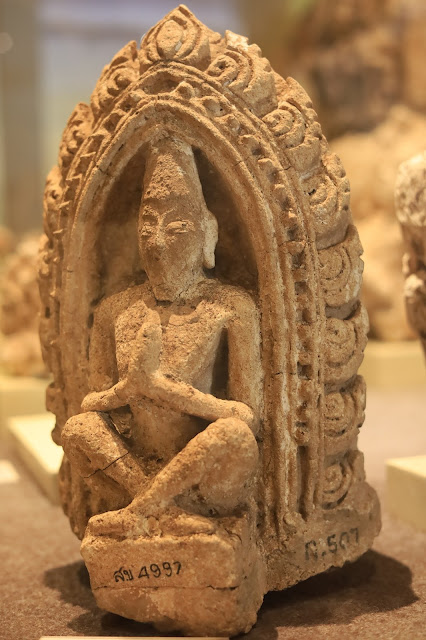พิพิธภัณฑสถานแห่งชาติ รามคำแหง จ.สุโขทัย
ที่อยู่: ตำบล เมืองเก่า อำเภอเมืองสุโขทัย สุโขทัย 64210
Tel.055633025
The Sukhothai Kingdom was a post-classical Thai kingdom (mandala) in Mainland Southeast Asia surrounding the ancient capital city of Sukhothai in present-day north-central Thailand. The kingdom was founded by Si Inthrathit in 1238 and existed as an independent polity until 1438.
ราชอาณาจักรสุโขทัยเป็นอาณาจักรไทยหลังยุคคลาสสิก (มันดาลา) ในแผ่นดินใหญ่ในเอเชียตะวันออกเฉียงใต้ ล้อมรอบเมืองหลวงโบราณของสุโขทัยในภาคเหนือตอนกลางของประเทศไทยในปัจจุบัน อาณาจักรนี้ก่อตั้งโดยกษัตริย์ พ่อขุนศรีอินทราทิตย์ในปี พ.ศ. 1238 และดำรงอยู่เป็นการเมืองอิสระจนถึง พ.ศ. 1438
พระต้นแบบสุโขทัยถือได้ว่าเป็น “ยุคทอง” ของศิลปะไทย พระปางลีลา พระปางไสยาสน์เป็นตัวอย่างที่ดีในสมัยสุโขทัย ถือเป็นการแสดงสัญลักษณ์ที่มีลักษณะเฉพาะและเฉพาะเจาะจงกับเวลานั้น
The Sukhothai model amulet is regarded as the "golden age" of Thai art. The Leela Buddha image The reclining Buddha image is a good example of the Sukhothai period.

The museum exhibits artifacts and antiques found during a series of excavations in Sukhothai Historical Park and Sri Satchanalai Historical Park in 1960s. Highlights of the museum are the Sukhothai-style Buddha images, regarded the most beautiful Buddhist image-style in the Thai history. Also, the exhibitions also display Chinese porcelain and precious artifacts that show to prosperity of Sukhothai during its heydays. Opening hours: Daily 9.00 a.m.-4.00 p.m. Admission: 150 baht
ชาวไทย 30 บาท ชาวต่างประเทศ 150 บาท นักเรียน นักศึกษาในเครื่องแบบ ภิกษุ สามเณร และนักบวชในศาสนาต่างๆ ไม่เสียค่าธรรมเนียมเข้าชม
แบบสุโขทัย หนึ่งในรูปแบบบัญญัติของพระพุทธรูปที่พัฒนาขึ้นในอาณาจักรไทของสุโขทัย (ไทยสมัยใหม่) เริ่มตั้งแต่ศตวรรษที่ 14 ความพยายามครั้งสำคัญอย่างน้อยสามครั้งติดต่อกันอย่างน้อยสามครั้งของกษัตริย์ไทในการสร้างศีล "ของแท้" สำหรับไอคอน รูปแบบสุโขทัยตามด้วยอู่ทองและประเภทสิงโต
อิทธิพลโดยตรงมากที่สุดต่อสไตล์สุโขทัยคือศิลปะของศรีลังกา
(ซีลอน) ซึ่งเป็นที่มั่นของพระพุทธศาสนาเถรวาทและเป็นแหล่งที่มาของภาพที่น่าคัดลอก ศาสนาพุทธเสื่อมถอยไปนานแล้วในอินเดีย
พระสุโขทัยประกอบด้วยส่วนโค้งโค้งมนและรูปทรงกระบอกทำให้เกิดความสง่างามที่ไม่มีกระดูกและไม่มีน้ำหนัก ส่วนต่างๆ ของร่างกายเป็นไปตามอุดมคติที่เป็นนามธรรมโดยเปรียบเทียบกับรูปแบบธรรมชาติ เช่น ไหล่เหมือนงวงช้าง ลำตัวเหมือนสิงโต และจมูกเหมือนจงอยปากนกแก้ว ใบหน้าและลักษณะเฉพาะจะยาวขึ้น ส่วนคิ้ว ตา จมูก และปากเป็นชุดของส่วนโค้งที่เด่นชัด โดยทั่วไปแล้วศีรษะจะมีลักษณะยื่นออกมาคล้ายเปลวไฟเหนือกะโหลก ซึ่งเชื่อกันว่าผู้ศรัทธาจะมีโพรงสมองเพิ่มขึ้น โดยทั่วไปแล้วพระพุทธเจ้าจะนั่งในท่าครึ่งดอกบัวด้วยมือขวาทำท่าทางสัมผัสดินหรือเดินด้วยเท้าข้างหนึ่งไปข้างหน้าและยกมือขวาขึ้นที่หน้าอก พระพุทธรูปเดินที่เรียกว่าเป็นการสร้างของชาวไทและไม่มีอยู่ในอินเดียในรูปแบบเช่นนี้

Sukhothai style, one of the canonical styles for Buddha icons developed probably in the Tai kingdom of Sukhothai (modern Thailand), beginning in the 14th century. As the first of at least three major successive efforts by Tai kings to establish an “authentic” canon for the icons, the Sukhothai style was followed by the U Thong and the lion types.
The most direct influence on Sukhothai style was the art of Sri Lanka (Ceylon), which was a stronghold of Theravada Buddhism and a source of images worthy of copying. Buddhism had long since declined in India.
The Sukhothai Buddha is composed of sinuous curves and cylindrical forms, creating a boneless, weightless elegance. The various portions of the body follow abstract ideals based on analogy with natural forms, such as shoulders like an elephant’s trunk, a torso like a lion, and a nose like a parrot’s beak. The face and features are elongated, and the brows, eyes, nose, and mouth are a series of strongly marked curves. The head typically bears a flamelike protuberance above a cranial bump, which is believed by the faithful to contain an extra brain cavity. The Buddhas are typically either seated in the half-lotus posture with right hand performing the earth-touching gesture or walking with one foot forward and the right hand raised to the chest. The so-called walking Buddha is a Tai creation and did not exist in India as a canonical type.
Britannica
Cr. Natee Tubtimthong

















































































No comments:
Post a Comment